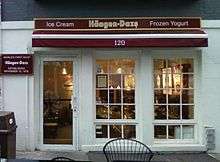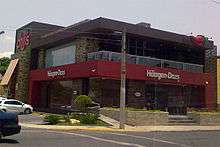Häagen-Dazs
 Company logo | |
| Subsidiary | |
| Industry | Retail |
| Founded | Bronx, New York (1961) |
| Founder | Reuben and Rose Mattus |
| Headquarters | Oakland, California, United States |
| Products | Ice cream |
| Parent | General Mills (Elsewhere) |
| Divisions | Nestlé Ice Cream (USA and Canada) |
| Website | HaagenDazs.com |
Häagen-Dazs /ˈhɑːɡəndɑːs/ is an ice cream brand, established by Reuben and Rose Mattus in the Bronx, New York, in 1961. Starting with only three flavors: vanilla, chocolate, and coffee, the company opened its first retail store in Brooklyn, New York, on November 15, 1976.[1] The business now has franchises throughout the United States and many other countries around the world including the United Kingdom, India, China and Brazil.[2]
Häagen-Dazs ice cream holds the distinction of being one of the few commercial ice cream brands not to use stabilizers such as guar gum, xanthan gum, or carrageenan. They do use corn syrup in many of their flavors, such as the Vanilla Swiss Almond, according to their website. The company also produces ice cream bars, ice cream cakes, sorbet, frozen yogurt, and gelato.[3]

Origin of brand name
Reuben Mattus invented the "Danish-sounding" "Häagen-Dazs" as a tribute to Denmark's exemplary treatment of its Jews during the Second World War,[4] and included an outline map of Denmark on early labels. The name is not Danish, which has neither an umlaut ä (rather, the ligature æ is the corresponding counterpart) nor a digraph zs, nor did the name have any meaning in any language before its creation.[5] Mattus felt that Denmark was known for its dairy products and had a positive image in the United States.[6] His daughter Doris Hurley reported in the 1999 PBS documentary An Ice Cream Show that her father sat at the kitchen table for hours saying nonsensical words until he came up with a combination he liked. The reason he chose this method was so that the name would be unique and original.[7]
Conflict with Frusen Glädjé
In 1980, Häagen-Dazs unsuccessfully sued Frusen Glädjé, an American ice cream maker founded that year, for using similar foreign branding strategies. The phrase frusen glädje—without the acute accent—is Swedish for "frozen delight".[8] In 1985, Frusen Glädjé was sold to Kraft General Foods. A Kraft spokeswoman stated that Kraft sold its Frusen Glädjé license to the Unilever corporation in 1993, but a spokesman for Unilever claimed that Frusen Glädjé was not part of the deal.[9] The brand has since disappeared.
Product description
Häagen-Dazs ice cream comes in several traditional flavors as well as several esoteric flavors that are specific to the brand, such as Vanilla Swiss Almond and Bananas Foster. It is marketed as a "super-premium" brand: it is quite dense (very little air is mixed in during manufacture), uses no emulsifiers or stabilizers other than egg yolks, and has a high butterfat content. Häagen-Dazs consumers are also directed to store their ice cream at 0 °F (−18 °C), a temperature substantially lower than that used for most ice creams, in order to keep its intended firmness.[10] It is sold both in grocery stores and in dedicated retail outlets serving ice cream cones, sundaes, and so on.
History
1910s

Häagen-Dazs's founder Reuben Mattus was born in Poland in 1912 to Jewish parents. His father died during the First World War, and his widowed mother emigrated to New York City with her two children in 1921.[11] They joined an uncle who was in the Italian lemon-ice business in Brooklyn. By the late 1920s, the family began making ice pops, and by 1929, chocolate-covered ice-cream bars and sandwiches under the name Senator Frozen Products on Southern Boulevard in the South Bronx, delivering them with a horse-drawn wagon to neighborhood stores in the Bronx.[4][5]
Mattus met Rose Vesel, who had arrived in New York with her Polish-Jewish parents from England at age five, in Brownsville, Brooklyn. After finishing high school, Vesel went to work as a bookkeeper at the Senator plant in 1934, and the two married in 1936.[12]
1950s

The Senator Frozen Products company was profitable, but by the 1950s the large mass-producers of ice cream started a price war that Mattus could not fight, leading to his decision to make a heavy kind of high-end ice cream. In 1959, he decided to form a new ice cream company with what he thought to be a Danish-sounding name, Häagen-Dazs,[4] a move known in the marketing industry as foreign branding.
1980s
Häagen-Dazs was bought by Pillsbury in 1983. General Mills bought Pillsbury in 2001.[13][14] In the United States and Canada, Häagen-Dazs products are produced by Nestlé subsidiary Dreyer's, which acquired the rights as part of the General Mills-Pillsbury deal.[15][16] The brand name is still owned by General Mills but is licensed to Nestlé in the US and Canada.
2000s
To offset increasing costs of their ingredients and the delivery of the product, Häagen-Dazs announced that in January 2009 it would be reducing the size of their ice cream cartons in the US from 16 US fl oz (470 ml) to 14 US fl oz (410 ml).[17] In March 2009 they announced that they would be shrinking the 32 US fl oz (950 ml) container to 28 US fl oz (830 ml).[18] In response, Ben & Jerry's said that they would not be changing the sizes of their cartons.[17][19]
In 2009, a sign that appeared to invite only foreigners to a newly opened Häagen-Dazs in New Delhi, India, led to complaints. The Indian subsidiary removed it and apologized.[20][21]
See also
References
- ↑ See sign outside that first store, shown at File:Häagen-Dazs' first shop.jpg.
- ↑ "History". Häagen-Dazs®. Retrieved September 25, 2011.
- ↑ "Products". Häagen-Dazs. Retrieved June 10, 2010.
- 1 2 3 Joan Nathan (August 2, 2012). "Ice Cream’s Jewish Innovators". Tablet Magazine. Retrieved August 7, 2012.
- 1 2 Dennis Hevesi (December 1, 2006). "Rose Mattus, 90, Co-Creator of Häagen-Dazs Ice Cream, Dies". The New York Times. Retrieved August 7, 2012.
- ↑ "Haagen-Dazs whips up Japan gains with tailor-blended ice cream". The Daily Yomiuri (Tokyo). August 16, 2004. p. 1.
- ↑ "An Ice Cream Show (1999)". The New York Times. Retrieved June 10, 2010.
- ↑ "Trade Dress Protection for Advertising Campaigns". Hall Dickler Kent Goldstein & Wood, LLP. Retrieved 2011-04-06.
- ↑ 'Whatever Happened To...Frusen Gladje? The Christian Science Monitor September 28, 2000
- ↑ Häagen-Dazs official website: Frequently Asked Questions
- ↑ Bobbie Stein (August 17, 1981). "Reuben Mattus Scooped the Competition with His Pricey and Nonsense-Named Haagen-Dazs". People Magazine. Retrieved August 7, 2012.
- ↑ Stephen Miller (December 1, 2006). "Rose Mattus, 90, Co-Founder of Häagen-Dazs". The New York Sun. Retrieved August 7, 2012.
- ↑ Barboza, David (July 18, 2000). "General Mills-Pillsbury Deal Includes Culture and History". The New York Times. Reuters. p. C.2. Retrieved June 10, 2010.
- ↑ "News Summary". The New York Times. October 24, 2001. p. C.1. Retrieved June 10, 2010.
- ↑ "Nestlé takes over Dreyer's". San Francisco Business Times. June 25, 2003. Retrieved June 10, 2010.
- ↑ "Haagen-Dazs scooped up". CNNMoney.com. December 26, 2001. Retrieved June 10, 2010.
- 1 2 York, Emily Bryson (March 9, 2009). "Ben and Jerry's Calls Out Haagen-Dazs on Shrinkage". Advertising Age. Retrieved June 10, 2010.
- ↑ "Our new Häagen-Dazs cartons". Häagen-Dazs. Retrieved June 10, 2010.
- ↑ partysugar (March 10, 2010). "Ben and Jerry's vs. Haagen-Dazs: A Pint-Sized Battle". YumSugar. Retrieved June 10, 2010.
- ↑ Dasgupta, Reshmi R. (December 17, 2009). "No Indians allowed; Haagen Dazs says wrong choice of words". The Times of India. Retrieved June 11, 2010.
- ↑ Angre, Ketki; Sharma, Manu (December 17, 2009). "Haagen-Dazs ad offends Delhi". NDTV. Retrieved June 10, 2010.
External links
- Official website, which includes links to their stores worldwide.
| ||||||||||||||||||||||||||||||||||||||||||||||||
| ||||||||||||||||||||||||||||||
